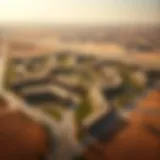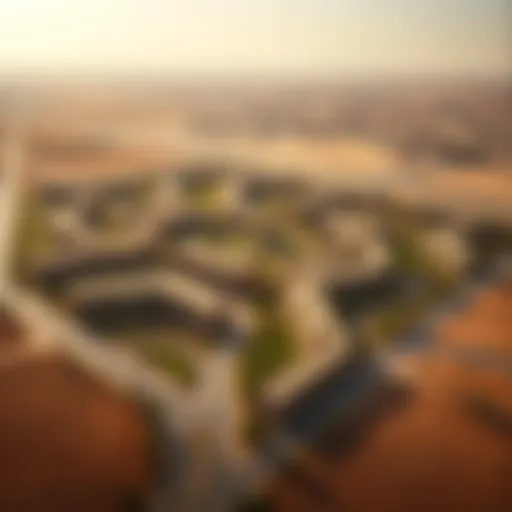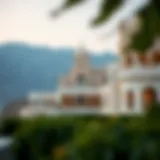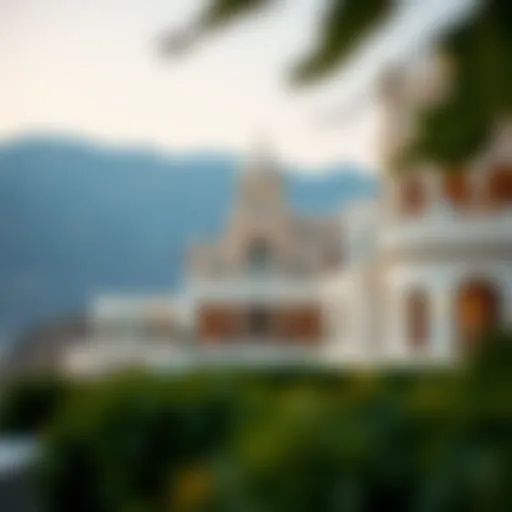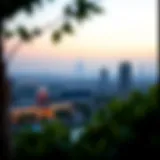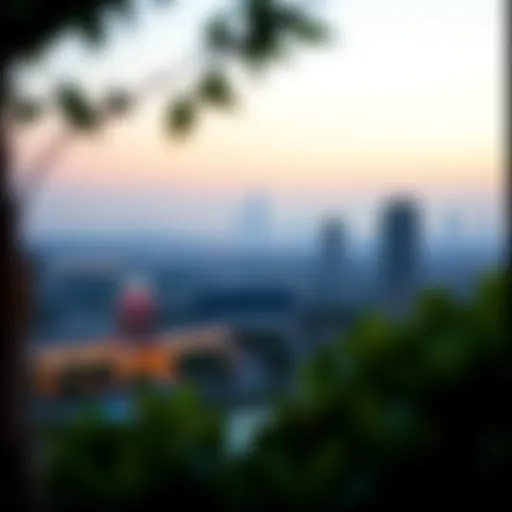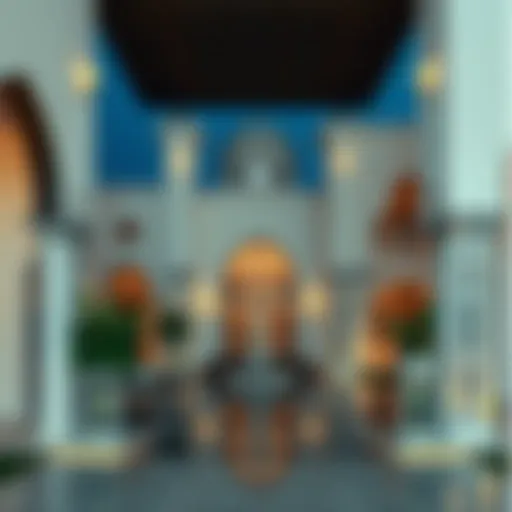Analyzing Dubai's Downtown Views and Real Estate Trends


Intro
The skyline of Dubai is a tapestry woven with breathtaking architecture and vibrant culture. From the iconic Burj Khalifa to the bustling Dubai Marina, the downtown views serve as both a magnet for tourists and a prime factor in real estate valuation. As the city burgeons with opportunities, investors are keen to grasp how these visual spectacles affect market dynamics, property desirability, and lifestyle choices.
This exploration dives into how captivating views can drive a wedge in the market, transforming ordinary living spaces into coveted addresses. With every towering structure, there lies potential—be it for personal use or as a lucrative investment. The aim here is to dissect these elements, offering valuable insights for discerning buyers, investors, and property developers.
Market Trends and Insights
Current Market Conditions
As of this year, the real estate landscape in Dubai continues to demonstrate resilience amidst global uncertainties. The allure of downtown views significantly enhances property values in prime locations. High-rise apartments with panoramic vistas are experiencing increased demand, particularly among expatriates and affluent buyers. The allure of the glittering skyline, paired with luxury amenities, positions these properties as prime investments.
It is noteworthy to acknowledge that views influence pricing. Properties overlooking parks, waterfronts, and city landmarks often command a 10% to 20% premium compared to similar properties lacking such scenic advantages.
Recent reports reveal a trend towards sustainable and green architecture, which is aiming to harmonize with the urban scenery. Development projects that integrate natural beauty with urban infrastructure are becoming increasingly popular. This shift will likely affect how future market conditions unfold, elevating both the aesthetic and financial appeal of various neighborhoods.
Future Predictions and Projections
Looking ahead, the expectation is that downtown views will continue to play a pivotal role in shaping the real estate market. Analysts project that as tourism returns to pre-pandemic levels, demand for properties with iconic views will surge. Furthermore, the upcoming Expo 2025 will draw even more attention to the area, likely enhancing property prices and rental yields.
A distinct feature emerging in the predicted market is the increased focus on smart homes. Buyers are expressing a growing preference for properties that offer technology-driven solutions combined with stunning vistas.
The demand for scenic views reinforced by advanced technology will form the backbone of future developments in downtown Dubai.
Investment Opportunities
Emerging Neighborhoods
While established locales remain attractive, emerging neighborhoods deserve attention. Areas like Dubai Creek Harbour and the Jumeirah Lakes Towers are slowly becoming not just desirable for their ambiance but also for their investment potential. These neighborhoods are integrating lush green spaces with urban environments, offering residents a balance of city life and tranquility.
The real estate market thrives on anticipation. For investors willing to look beyond the well-trodden paths, buying property in these emerging spaces can yield substantial returns as cities evolve.
Types of Properties to Invest In
Investors have numerous options based on their budget and goals. Here’s a brief rundown:
- Luxury Condominiums: These offer breathtaking views coupled with high-end amenities.
- Mid-range Apartments: Still competitive in the market, often located in emerging areas with development potential.
- Commercial Spaces: For those looking into enterprise investments, properties in bustling districts can yield steady rental income.
Investing in properties with downtown views not only ensures an aesthetically pleasing living environment but also capitalizes on rising demand. Through careful analysis of market trends, investors can tailor their portfolios to match the evolving landscape of Dubai.
In summary, the exploration of downtown views in Dubai is more than just a visual pursuit. It plays a central role in determining the trajectory of the real estate market, creating a myriad of opportunities for discerning investors. By keeping an eye on emerging neighborhoods and types of properties, one can position themselves favorably for the future.
Prelude to Downtown Views
In today’s rapidly urbanizing world, the importance of downtown views cannot be overstated. These vistas offer more than just a feast for the eyes; they can shape lifestyles, influence real estate markets, and enrich urban design strategies. In this ever-evolving environment, understanding the nuances of downtown views is key for investors, homebuyers, agents, analysts, and developers.
Defining Downtown Views
To get a grasp on downtown views, we can start by breaking them down into several components. At their core, these views are reflections of the urban fabric—composed of architectural styles, natural landscapes, and dynamic city life. Think of them as the city’s calling card. Whether it’s the shimmering skyline or the charming alleyways, downtown views encapsulate the essence of city living.
These views can vary greatly depending on one's location, vantage point, and even the time of day. Some individuals may admire the glint of glass skyscrapers under the midafternoon sun while others might appreciate the warm glow of street lamps at dusk. Each perspective narrates its own story and contributes to the overall identity of the downtown area.
Significance in Urban Design
This brings us to the broader significance of downtown views in urban design. The layout of a city is often a balance of aesthetic appeal and functional infrastructure. Beautiful views can transform an ordinary space into a vibrant urban experience. Planners and architects understand that the integration of striking visuals can enhance public spaces, increase foot traffic, and elevate property values.
Moreover, urban design strategies that prioritize downtown views can create a sense of place and belonging. As people stroll along well-designed walkways or relax in parks that offer scenic backdrops, they forge connections to their environment, contributing to a vibrant community life. Designing with sightlines in mind isn't just about beauty; it's about fostering connections in urban landscapes.
"A well-planned urban view can become a source of pride for the community, while also being a substantial draw for potential investors."
In the context of Dubai, the downtown views showcase more than just buildings. They highlight the emirate's ambition and innovation, thus making it a significant area for real estate investment. With its impressive architecture and scenic backdrops, the downtown area calls to investors and home seekers alike, promising a blend of luxury living and cultural richness.
As we move forward in this analysis, we will explore different facets of how these views influence architecture, culture, and investment dynamics, shedding light on the intricate relationship between vistas and urban development.


For more information on urban design principles, visit Wikipedia on Urban Design. For perspectives on investment opportunities in major cities around the world, check out Britannica’s coverage on Urban Investment.
Architectural Highlights
When one strolls through a cityscape, the architectural highlights frame its identity. Downtown views in a place like Dubai are not merely about the buildings; they embody the soul and ambitions of the urban environment. The intricate interplay between structures not only shapes the skyline but also reflects cultural narratives, economic vitality, and artistic expression.
The importance of focusing on architectural highlights is manifold. First, it reveals how design choices impact the livability of urban areas. Well-designed buildings can enhance the residential appeal of a region, influencing both property values and the quality of life for its residents. Also, architectural highlights give potential investors insights into the market's direction by indicating which areas are thriving and which models of design attract favorable attention.
Iconic Structures
In the realm of architecture, iconic structures are the stars of the show, drawing eyes from both afar and up close. Take the Burj Khalifa, for instance. Its towering presence acts as a beacon for tourists and locals alike, symbolizing human achievement and innovative design. On the other end of the spectrum is the Dubai Frame, which serves not only as a vista spot but also as an Instagram hotspot, combining functionality with a striking visual identity.
Investors often look at these types of structures as key indicators. They illustrate the potential for development trends and real estate appreciation in the surrounding areas. Iconic buildings foster a sense of community and engagement, offering public spaces that invite interaction and collaboration – essential ingredients for any thriving urban neighborhood.
Innovative Design Elements
As we step into the future of urban living, innovative design elements play a crucial role in shaping downtown landscapes. Features like green rooftops and integrated technology are not just buzzwords; they signal a shift towards sustainability and smarter living. For instance, developments that incorporate solar panels and rainwater harvesting systems prominently light the way forward for eco-conscious investors.
Moreover, mixed-use buildings, which blend residential, commercial, and recreational spaces, help create a vibrant urban fabric. These designs are more than architectural feats; they redefine how communities interact and foster connections between diverse groups.
Continual advancements in material science also allow for bold designs that weren't feasible just a few decades ago. 3D-printed structures, for instance, are beginning to make waves, minimizing waste and maximizing design potential. All these factors contribute to a more engaged public and create immersive experiences that heighten the allure of downtown views.
The Role of Modernist Architecture
Modernist architecture has reshaped urban environments and is particularly significant in places like Dubai, where tradition meets forward-thinking design principles. This form emphasizes function over form; practicality melds with aesthetics to produce clean lines and open spaces, often blurring the inside and the outside to create connected experiences.
From structures like the Dubai Mall to the Museum of the Future, modernist architecture often offers insights into how cities can utilize space efficiently while maintaining an allure. These buildings encourage community interaction and conviviality, translating into longer-term economic benefits, especially for those in the real estate sector.
In a nutshell, the architectural highlights of downtown views provide a window into the dynamics of urban growth, lifestyle appeal, and investment viability. Emphasizing structures and designs that stand out not only captivates residents but also sets the stage for future development and sustainability in Dubai's ever-evolving landscape.
Cultural Implications
Understanding the cultural implications of downtown views is essential for investors and developers alike. These elements go beyond mere aesthetics; they influence urban identity, foster community spirit, and drive economic resilience. The interplay of art, public spaces, and community engagement shapes the urban fabric and can have a substantial impact on residential appeal and commercial viability.
Art and Public Spaces
Art isn’t just a decorative element found on gallery walls; it permeates public spaces, breathing life into the very essence of downtown areas. Public art installations often reflect local culture and history, and can serve as landmarks that attract foot traffic. For instance, the stunning Dubai Fountain not only enhances the aesthetics of Downtown Dubai but also brings together locals and visitors in a communal experience.
The incorporation of art can be thematic or site-specific, allowing urban planners to narrate a story unique to that area. Local artists may express cultural narratives, or significant events, and this ‘sense of place’ can instill a feeling of belonging among residents. Many cities worldwide invest in public art initiatives, aiming to create spaces that resonate with community members.
Some benefits of integrating art into public spaces include:
- Enhanced Aesthetic Appeal: Artistic installations can elevate the overall beauty of the area, encouraging more visitors.
- Cultural Reflection: Art can echo the stories and customs of the local community, fostering a deeper understanding of the area's heritage.
- Engagement Opportunities: Events around art, such as festivals or exhibitions, can bring communities together, enhancing social capital.
Community Engagement and Urban Life
Community engagement plays a critical role in shaping urban life. It is vital for residents to feel connected to their neighborhoods; this connection can foster pride and responsibility. Downtown views, which showcase vibrant public areas, invite a spectrum of activities ranging from casual gatherings to organized events, building a lively urban experience.
Such community engagement might involve open forums where residents voice concerns and ideas for public space usage. Thriving marketplaces or community gardens enhance interaction among residents, while recreational areas promote active living, creating an environment where urban life flourishes.
Key considerations in fostering community engagement include:
- Accessibility: Public spaces should cater to a diverse demographic, ensuring everyone can participate in community activities.
- Inclusive Programming: Offering a variety of events that appeal to different age groups and cultures can maximize participation.
- Feedback Mechanisms: Facilitating platforms where community members can express their opinions helps in making informed decisions about urban development.
Investment Opportunities
The landscape of downtown views presents a fertile ground for investors, as the interplay of urban development and aesthetic appeal shapes dynamics in real estate markets. Not only do these views enhance property desirability, but they often translate into higher resale values and rental incomes. Here, we break down vital components and considerations regarding investment opportunities in areas with captivating cityscapes.
Real Estate Trends in Downtown Areas


When we talk about real estate, especially in densely populated urban environments, trends often fluctuate like a stock ticker. What makes downtown areas tick?
- Location, Location, Location: Properties that offer stunning views are positioned at a premium. A skyline dotted with skyscrapers can be too enticing for both homebuyers and renters. For instance, neighborhoods near the Burj Khalifa in Dubai generally command higher interest due to their panoramic landscapes.
- Shifts in Buying Patterns: As millennials and young professionals increasingly seek urban living, there’s a growing market for mixed-use developments. These setups not only provide accommodation but also integrate shopping, dining, and recreational spaces right at the doorstep.
- Technological Influence: Developments in smart technology have made properties more appealing. Modern buildings equipped with energy-efficient systems, smart home features, and aesthetic designs enhance the living experience and make them attractive to investors.
- Demand Surges Post-Pandemic: As life returns to normal, urban centers see renewed interest. With people keen on returning to a vibrant lifestyle, or even just proximity to workplaces and social scenes, areas that show premium views experience a resurgence in demand.
Market Analysis: Scenarios and Predictions
Understanding the market landscape is akin to reading a treasure map. Several scenarios might play out in the coming years:
- Continued Appreciation of Properties: Over the next several years, properties with unique viewpoints may appreciate faster than the general market, creating a prime opportunity for investment. An estimated annual growth rate of 5-7% is plausible, especially in cities where urban revitalization is underway.
- Emerging Neighborhoods: Look out for formerly underappreciated areas being transformed into urban havens. Strategic urban planning often capitalizes on the blend of affordability and views, making these regions prime for long-term bets. For instance, previous focus on areas like Dubai Marina serves as a prime example of what’s possible.
“Investors should keep a keen eye on local government initiatives aimed at improving public spaces. Such developments bolster property values in the surrounding areas.”
- Shifts Toward Sustainability: Green building certifications increasingly influence buying decisions. Properties that showcase sustainability while offering stunning vistas are gaining traction. Developers keen on securing investments should focus on eco-friendly designs paired with scenic views.
- Market Volatility: Investors need to be mindful of economic factors influencing market health. Interest rates, regulatory changes, and global economic patterns can present both risks and opportunities for astute investors.
Residential Appeal
In today’s urban environment, the residential appeal of downtown areas has become a focal point for those looking to invest or relocate. The allure of living in a vibrant city center with convenient amenities, cultural attractions, and unique surroundings cannot be understated. This article examines key aspects of residential appeal, particularly in relation to downtown views, focusing on elements that matter for homebuyers, investors, and urban planners alike.
Lifestyle Considerations
When it comes to choosing a residence in downtown Dubai, lifestyle considerations play a pivotal role. The heartbeat of the city offers a lifestyle filled with opportunities. People are drawn to the convenience of having restaurants, shops, and recreational activities right at their doorstep. This dynamic lifestyle enhances day-to-day living, making it more exciting and multifaceted.
Walking down bustling streets or relaxing in nearby parks adds vibrancy to urban life. Social interactions become easier, leading to community-building—a huge plus for those who seek connectivity in their surroundings. The close-knit vibe of downtown living fosters a sense of belonging. Moreover, being situated near business centers often means a reduced commute, leading to a better work-life balance.
"Living in the thick of things can boost not only your social life but also your career prospects."
In addition to lifestyle benefits, the aesthetics of downtown views cannot be dismissed. Towering skyscrapers and stunning architectural designs present an ever-changing canvas, influenced by a blend of nature and urbanity. This visual stimulation ensures that residents are not just living, but thriving in their environments.
Amenities and Accessibility
Amenities and accessibility are crucial components of residential appeal. In downtown Dubai, the convenience of having a plethora of services nearby is unmatched. Shopping malls, cultural hubs, and fitness centers are often within walking distance, making everyday errands manageable and ,easy. Residents enjoy the perks of swift access to grocery stores, hospitals, and schools, all essential for daily life.
Accessibility extends beyond the confines of immediate amenities. Public transportation options, including the metro and bus services, play a significant role in urban living. Efficient transit systems reduce reliance on personal vehicles, easing congestion and minimizing environmental impacts. For many, the ability to get to key destinations without the hassle of traffic is a compelling motivator.
Moreover, outdoor amenities like parks and recreational spaces provide a necessary balance to urban life. The opportunity to take a leisurely stroll, engage in outdoor sports, or simply relax contributes to a healthier lifestyle. Residents benefit from these green spaces, as they serve as communal areas for families, friends, and neighbors, enhancing social interaction.
In summary, the residential appeal for downtown dwellers in Dubai is multifaceted. It combines the excitement of a rich urban lifestyle with the convenience of modern amenities, all framed by stunning views. Investors and homebuyers alike should consider these vital aspects when evaluating the opportunities presented by downtown living.
Visual Experience
The visual experience of downtown areas plays a crucial role in how people interact with their environment. It can deeply influence residents' quality of life and investors’ decisions. Panoramic vistas provide a sense of openness, breaking the monotony that towering structures can create. Further, when considering locations in Dubai, there’s an undercurrent of vibrancy found in its ever-evolving landscape. High-rise buildings, combined with expansive parks and natural features, create a dynamic visual tableau that continuously captivates those who pass through.
Panoramic Views and Landscapes
Panoramic views not only offer aesthetic pleasure but also usher in several significant benefits. One cannot downplay the psychological advantages tied to breathtaking landscapes. For instance, a residence facing the iconic Burj Khalifa can guarantee a sense of prestige and allure, while also housing potential buyers enticed by a constantly evolving skyline. In Dubai, such views are not merely decorative aspects; they become a symbol of status, impacting property values and rental markets.
A clear understanding of the interplay between visual landscapes and architectural elements can inform investment strategies:
- Market Value: Properties with stunning views often command higher prices. Investors keen on maximizing their returns should prioritize buildings with strategic sightlines.
- Lifestyle Enhancements: Access to beautiful views can enhance overall living experiences, making downtown areas more appealing to diverse demographics, from young professionals to families.
- Tourism Attraction: Landscapes that provide picturesque views can draw in tourists, vital for local economies and rental opportunities.
“The allure of a spectacular view can turn an ordinary dwelling into a desirable enclave.”
Indeed, when potential buyers perceive a blend of natural beauty and architectural achievement, their emotional connection often translates into solid investments.
The Impact of Lighting and Environment
The influence of lighting on architectural presentations cannot be overstated. In a city like Dubai, where the weather can be intense, how a structure interacts with natural light can dictate the effectiveness of the overall urban experience. Daylight streaming through expansive windows can energize spaces, while well-designed artificial lighting can create welcoming atmospheres during the evening.
Investigating the environmental context further reveals multiple angles to consider:


- Natural Light Optimization: Buildings oriented to catch maximum sunlight can enhance indoor climates while reducing energy costs. This creates an appealing narrative for eco-conscious investors.
- Reflective Surfaces: The strategic use of glass facades can amplify the surrounding landscape, reflecting dazzling images of the skyline, which enriches the overall visual fabric of downtown.
- Seasonal Transformations: Different times of the year bring varying behaviors from sunlight, influencing daily experiences differently—a point crucial for retail spaces and restaurants to consider when designing their venues.
Such factors underscore the necessity of integrating light as a core element in urban planning. Smart designs that respond to environmental lighting can bolster aesthetic values while maximizing function. Investors who acknowledge these elements tend to secure properties that not only attract attention but also promise longevity in a shifting market.
Overall, the visual experience is woven into the very essence of downtown landscapes. Investors and developers should not overlook its intricacies, for they are foundational to thriving urban ecosystems that appeal to both residents and visitors alike.
Challenges and Considerations
Understanding the challenges and considerations surrounding downtown views is vital for anyone engaged in Dubai's dynamic real estate market. It's not just about pretty panoramas; the realities of urban density and infrastructure, along with pressing environmental concerns, play crucia roles in shaping the landscapes—the view that potential buyers and investors encounter.
In today's fast-paced world, developers must navigate several challenges while also seizing opportunities presented by iconic vistas. This discussion emphasizes a balanced approach, where potential pitfalls are addressed alongside the fruitful aspects of urban developments.
Urban Density and Infrastructure
Urban density in Dubai presents a double-edged sword. On one hand, it fosters a vibrant lifestyle full of amenities and close-knit communities, but on the other, it strains infrastructure and public resources. As real estate pushes into the sky, one must consider how high-density living affects the overall quality of life and accessibility.
Significant elements to consider include:
- Transportation Systems: The effectiveness of public transport, such as the Dubai Metro, directly influences the desirability of downtown areas. If residents find themselves stuck in traffic, the allure of scenic views diminishes significantly.
- Public Spaces: Green areas and parks are critical for a city's balance. The more residents crammed into a space, the greater the need for refreshment spots and leisure areas. Without these, even the most stunning views can feel like a crowded cage.
- Services and Utilities: Water, electricity, and waste management needs escalate with urban growth. If these services can't keep pace, the quality of living diminishes and can deter people from investing.
Our urban landscape shapes our daily encounters, so it's pivotal to ensure that functionality meets aesthetic appeal.
A well-planned downtown area can lead to higher property values and an elevated lifestyle, yet neglecting infrastructure can result in significant setbacks. Capable city planning should integrate urban designs that promote a functional coexistence of density and livability.
Environmental Sustainability
The conversation around environmental sustainability is becoming ever more pressing, particularly in a city like Dubai known for its dazzling architecture that often competes with nature's elements. Maintaining the delicate balance between development and preservation requires consideration of various sustainability challenges.
Key points for a sustainable urban view include:
- Green Building Practices: Implementing eco-friendly materials and energy-efficient technologies can significantly impact both the environment and long-term cost savings for homeowners. Seek products that align with environmental stewardship, such as solar panels or rainwater harvesting systems.
- Biodiversity Protection: Urban development can threaten local ecosystems. A design that considers wildlife corridors and promotes native plants can contribute positively to the biodiversity in these urban landscapes.
- Climate Resilience: As climate change brings unpredictability—from scorching summers to extreme rains—integrating resilience into urban design is crucial. This can mean developing flood management systems or creating shaded public spaces that offer relief from heat.
Overall, the future of urban views hinges not solely on architectural grandeur but on the sustainability of our choices moving forward. Through thoughtful planning and responsible development, we can ensure that these breathtaking views contribute to a vibrant, livable city for generations to come.
Future Developments
The topic of future developments in downtown areas is paramount, especially in a bustling metropolis like Dubai, where the skyline continuously evolves. Understanding these developments is crucial for investors, homebuyers, and developers alike, as they pave the way for emerging opportunities, shifts in real estate value, and an enriched urban lifestyle. As the city looks forward, the implications of these changes hold significant weight, not just for aesthetic appreciation but also for economic repositioning and community development.
Emerging Projects and Innovations
Dubai's urban landscape is a playground for architects and developers. Numerous projects are currently set to redefine the notion of downtown living. For instance, projects like the Dubai Creek Tower are not just tall structures but symbols of ambition and innovation that reflect the spirit of the city.
- Smart City Initiatives: Innovations in technology are leading to the creation of smart buildings. %*The integration of AI and sustainable technologies into architectural designs is making a ripple in the market.*% These structures prioritize energy efficiency, user accessibility, and integration with urban ecosystems.
- Public Spaces: Projects focusing on enhancing public spaces are key. Parks entwined with art installations or waterfront promenades are transforming how residents interact with the city. These additions provide not just beauty but foster community bonding, enabling people to experience the city in new ways.
- Mixed-Use Developments: The merging of residential, commercial, and recreational spaces is gaining traction. This concept allows for a lively, vibrant atmosphere, where life and work can coexist seamlessly. For investors, understanding these trends means recognizing the appeal these mixed-use avenues offer in terms of livability and business potential.
Predictions for Skyline Transformations
Looking ahead, how will Dubai's skyline continue to change? Opinions vary, but certain key trends appear to be shaping up.
- Height and Density: Experts suggest that height will still matter, yet there will also be a focus on sustainable development practices. Buildings that combine height with ecological considerations are more likely to attract attention and investment.
- Iconic Landmarks: More landmarks embodying both cultural heritage and modern design are anticipated. As Dubai seeks to maintain its position as an international hub, the formation of unique structures that tell a story will captivate visitors and residents alike.
- Vertical Gardens and Green Architecture: Expect to see more green spaces in high-rise buildings. Vertical gardens not only enhance aesthetic appeal but also contribute to air quality and the overall environmental sustainability of the urban ecosystem. This trend aligns with wider global movements towards greener urban spaces.
"The skyline of a city is not just a representation of its height, but a reflection of its vision, values, and the promise of what’s to come."
Finale
The significance of downtown views transcends mere aesthetics; they fundamentally shape the urban experience and influence economic viability in a city. In an article that analyzes the downtown views in Dubai, it becomes clear that these vistas are not just pretty pictures for postcards; they are critical elements that drive investor interest and life's dynamics in the city.
Synthesis of Insights
Through the careful examination of architectural elements, community engagement, and market patterns, we gain a multifaceted understanding of the role downtown views play in urban environments. The appeal of panoramic sights prompts homeowners to settle in these neighborhoods, while their unique allure contributes to attracting substantial investment opportunities. This interplay between visibility and desirability lays the groundwork for a vibrant real estate market.
- Visual Appeal: The captivating skyline of Dubai fosters a sense of prestige and exclusivity.
- Architectural Significance: Iconic buildings like Burj Khalifa and The Dubai Mall serve as landmarks that define the landscape.
- Community Engagement: Spaces are designed for interaction, providing both recreational and cultural venues that are enhanced by the views.
- Market Trends: The demand for properties with downtown views signals a growing importance for developers to catch the eye with their projects.
Final Thoughts on Downtown Views
"In real estate, location matters, but view matters even more. A skyline is a picture painted by both architects and investors alike.”
Embracing the multifaceted nature of downtown views will allow stakeholders to make more informed choices, balancing lifestyle aspirations with profitable investment opportunities. It’s clear that the tales told by these vistas will echo throughout Dubai’s development narrative.
